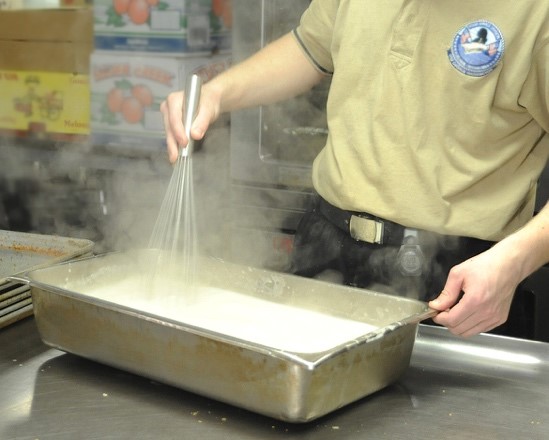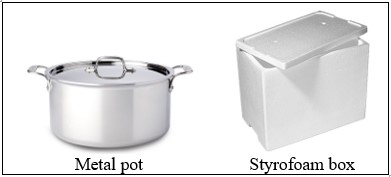Item AP061003: Apply scientific ideas about the transfer of energy and the availability of energy within a system to explain which system best thaws frozen soup. (MC Version)
A chef prepares a large batch of soup. He divides it into smaller batches that he freezes until he is ready to serve them.

To thaw the frozen soup, he places a bag of frozen soup (-10 oC) into a metal pot of cool water (12 oC) and covers it.
1. Using ideas about energy transfer, predict how the energy of the bag of soup and the surrounding water will change as the bag of soup sits in the pot of 12 oC water.
A. The amount of energy the soup has will stay the same, and the amount of energy the water has will decrease until the water has the same amount of energy as the soup.
B. The amount of energy the soup has will increase until the soup has the same amount of energy as the water, and the amount of energy the water has will stay the same.
C. The amount of energy the soup has will increase, and the amount of energy the water has will decrease until they have the same amount of energy.
D. The amount of energy the soup has will increase, and the amount of energy the water has will decrease but they will never have the same amount of energy.
After five minutes, the chef looks at the bag of soup and notices that most of it is still frozen. He takes the temperature of the soup and water and finds that they are both at 0 oC. He decides to wait another five minutes and looks again. After ten minutes, most of the soup is still frozen, and both the water and the soup are still at 0 oC.
2. Use ideas about energy transfer to explain why the water did not thaw the soup completely.
The chef wonders what effect using a Styrofoam container would have on the temperature change of the water and soup. He fills the metal pot and a Styrofoam box with warm water that is 33 oC and then places a bag of frozen soup at -10 oC in each container. For each container, he places thermometers in the water, in the soup, and right outside the containers.

He takes the temperature of the water, soup, and air right outside of the containers every 5 minutes for 20 minutes.
| Metal pot system | Styrofoam box system | |||||
|---|---|---|---|---|---|---|
| Time | Temp. of water | Temp. of soup | Temp. of air outside container | Temp. of water | Temp. of soup | Temp. of air outside contain |
| 0 | 33oC | -10oC | 20oC | 33oC | -10oC | 20oC |
| 10 | 25oC | 3oC | 21oC | 24oC | 4oC | 20oC |
| 15 | 23oC | 12oC | 22oC | 20oC | 14oC | 20oC |
| 20 | 22oC | 14oC | 22oC | 19oC | 17oC | 20oC |
3. What patterns of temperature change do you see in the data in the table for the metal pot system?
A. The temperatures of the water and the air outside the metal pot stay the same and the temperature of the soup increases.
B. The temperature of the water increases as the temperatures of the soup and the air outside the metal pot decrease.
C. The temperature of the water decreases as the temperatures of the soup and the air outside the metal pot increase.
D. The temperature of the water decreases as the temperature of the soup increases but the temperature of the air outside the metal pot stays the same.
4. Based on the patterns in the data, what can be concluded about the transfer of energy between the water, soup, and air in the metal pot system?
A. Energy is transferred from the soup to the water and from the air outside the metal pot to the water.
B. Energy is transferred from the soup to the water and from the soup to the air outside the metal pot.
C. Energy is transferred from the water to the soup and from the water to the air outside of the metal pot.
D. Energy is transferred from the water to the soup but not from the water to the air outside of the metal pot.
5. What patterns of temperature change do you see in the data in the table for the Styrofoam box system?
A. The temperatures of the water and the air outside the Styrofoam box stay the same and the temperature of the soup increases.
B. The temperature of the water increases as the temperatures of the soup and the air outside the Styrofoam box decrease.
C. The temperature of the water decreases as the temperatures of the soup and the air outside the Styrofoam box increase.
D. The temperature of the water decreases as the temperature of the soup increases but the temperature of the air outside the Styrofoam box stays the same.
6. Based on the patterns in the data, what can be concluded about the transfer of energy between the water, soup, and air in the Styrofoam box system?
A. Energy is transferred from the soup to the water and from the air outside the Styrofoam box to the water.
B. Energy is transferred from the soup to the water and from the soup to the air outside the Styrofoam box.
C. Energy is transferred from the water to the soup and from the water to the air outside of the Styrofoam box.
D. Energy is transferred from the water to the soup but not from the water to the air outside of the Styrofoam box.
7. Based on patterns you observed in the data, in which container does the temperature of the soup increase the most?
A. Metal pot
B. Styrofoam box
8. Use the data in the table and what you know about energy transfer to explain why the temperature of the soup increases more in one container compared to the other.
- Percent of Points Earned

- Points Earned
| Avg. Earned | Possible | Percent | |
|---|---|---|---|
| Q1 | INF | INF | 48% |
| Q2 | INF | INF | 23% |
| Q3 | INF | INF | 59% |
| Q4 | INF | INF | 52% |
| Q5 | INF | INF | 48% |
| Q6 | INF | INF | 50% |
| Q7 | INF | INF | 59% |
| Q8 | INF | INF | 10% |
- Overall Task Difficulty
| Total Points Earned | Total Points Possible | Total Percent | |
|---|---|---|---|
| INF | INF | 34% |
n =
Note: The total percent is a weighted average based on the total number of points earned divided by the total number of points possible.
- Science and Engineering Practices
- SEP4 Analyze data to identify design features or characteristics of the components of a proposed process or system to optimize it relative to criteria for success.
SEP6 Apply scientific ideas, principles, and/or evidence to provide an explanation of phenomena and solve design problems, taking into account possible unanticipated effects. - Crosscutting Concepts
- CC2 Cause and effect relationships may be used to predict phenomena in natural or designed systems.
CC5 Changes of energy and matter in a system can be described in terms of energy and matter flows into, out of, and within that system. - Disciplinary Core Ideas
- PS3.B Energy is spontaneously transferred out of hotter regions or objects and into colder ones.
PS3.B The availability of energy limits what can occur in any system.
PS3.B Uncontrolled systems always evolve toward more stable states--that is, toward more uniform energy distribution (e.g., water flows downhill, objects hotter than their surrounding environment cool down).

